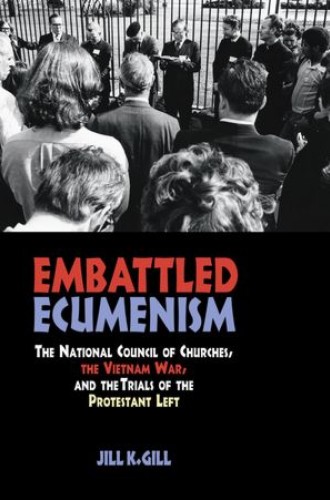Embattled Ecumenism, by Jill K. Gill
In her remarkable account of the declining influence of mainline Protestantism and, especially, the National Council of Churches during the 1960s and 1970s, historian Jill Gill refuses to advance a singular cause, but no argument is more persuasive than a couple of lines she drops quietly on page 322: “One might assume that church leaders would have adopted a moral approach from the beginning,” she writes. “But they did not.” That strategic failure may have been responsible more than anything else for the rupture between the leaders of mainline Protestantism and the people in the pews.
The larger narrative of Gill’s Embattled Ecumenism, rendered in excruciating detail, begins with the Federal Council of Churches and intensifies after World War II with the formation of the National Council of Churches during a snowstorm in Cleveland in 1950. After an initial false step—she traces the liberal-evangelical divide in American Protestantism to the fundamentalist-modernist controversy of the 1920s rather than to divergent responses to social changes late in the 19th century—Gill quickly regains her footing.
Read our latest issue or browse back issues.
She writes about John Foster Dulles, the future secretary of state, who chaired the Commission on a Just and Durable Peace for the Federal Council of Churches in 1940, but whose capitulation to the containment ideology of the cold war put him increasingly at odds with Protestant ecumenists—a foreshadowing of larger divisions to come.
Mainline Protestant sympathy for the civil rights movement emerged fairly quickly, Gill writes, but the assumption on the part of ecumenists that they could segue easily into opposition to the Vietnam War proved chimerical. Charges that the NCC was soft on communism dated to the aftermath of the Chinese Revolution of 1949, and critics found it easy to apply that rhetoric to antiwar protesters.
The NCC enjoyed access to the Eisenhower and Kennedy administrations, but Lyndon Johnson, whom the ecumenists overwhelmingly supported over Barry Goldwater in 1964, began to tire of the antiwar rhetoric emanating from the Interchurch Center. The NCC’s first open denunciation of the war came in 1965, and although Gill characterizes it as tepid, “it was one of the first such statements by a large, national, mainstream American institution against the war.”
Gill’s recounting of the Vietnam War, laced with ecclesiastical intrigue, is superb. She sorts out the various internal agencies as well as the fraught relationship between the NCC and Church World Service. Robert Bilheimer and Gerhard Elston emerged as the most diligent NCC operatives against the war, while the organization Clergy and Laymen Concerned about Vietnam became the most prominent and effective religious antiwar group. It was under the aegis of CALCAV that Martin Luther King Jr. came out against the war at Riverside Church on April 4, 1967, thereby fracturing his working relationship with Johnson. The NCC pursued direct contacts with North Vietnam, tried to ease the plight of conscientious objectors and continued its political agitation in opposition to the war.
All of this activism came at a price, financial and otherwise. The NCC’s diminished clout with the political elite in Washington coincided with growing discontent among the laity. Because the NCC was a confederation of denominations, it had no direct access to congregants; it depended on denominational leaders to communicate with the laity, and as those officials began to feel the heat from their members, communication and financial support diminished.
By the time of the NCC’s 1969 meeting in Detroit, the antiwar coalition within the council was unraveling, split between “coalition” activists and “those who felt the times called for ‘confrontation’ tactics, including civil disobedience.” James Forman, armed with his Black Manifesto, accused the NCC of focusing too much on Vietnam rather than racism. The gathering turned into a donnybrook. Stephen Rose, a graduate of Union Theological Seminary, presented a proposal that would have drastically affected the entire organization, and other groups called for giving all church property to Native Americans and supporting the legalization of marijuana, among other measures. A protester dumped red paint on the speakers’ table. Delegates narrowly refused to hold an earnest young man’s draft card “in trust” as he fought conscription.
The effect of the 1969 general assembly, Gill says, was to move the NCC farther to the left, while “much of the nation’s white majority backlashed against the so-called rioters, bra burners, hippies, and draft dodgers, and liberal East Coast elites who coddled them.” Reaction set in among the Protestant faithful, especially Richard Nixon’s “silent majority.” The archfundamentalist Carl McIntire mobilized his minions, Spiro Agnew went on the attack, the Internal Revenue Service audited the NCC, and Nixon crowed, “We’ve got those liberal bastards on the run now, and we’re going to keep them on the run.”
By this time, beset by dramatically shrinking budgets, Bilheimer and others realized that they had failed to build a moral argument against the war in Vietnam, especially one that could be communicated to the laity. An Ecumenical Witness conference in Kansas City in 1972 sought to provide theological ballast to the antiwar movement, but the attempt to invoke the just war theory to condemn the war was too little, too late.
Bilheimer returned from that gathering deflated. “I came home saying I don’t understand things anymore,” he told Gill. “People were just mad. Anything that was proposed was ‘wrong.’ None of us could figure out how to get people to work together. It was a sad, sad experience.” Peter Berger and Richard John Neuhaus severed their ties to CALCAV—the latter, Gill suggests, because he wanted to retain his influence as the nation drifted to the right.
Needless to say, “the NCC had an adversarial relationship with the Reagan White House,” Gill writes, “particularly on foreign policy,” given the administration’s nuclear arms buildup, its support for anticommunist dictators in Latin America and its reluctance to enact sanctions against South Africa for apartheid. The NCC enjoyed better relations with the Clinton administration. It was able to muster some opposition to George W. Bush’s invasion of Iraq, but it has never been able to organize a ground game approaching that of the religious right.
Still, Gill advocates ecumenism. “Even though the whole notion of bureaucratic national ecumenism has lost its sex appeal since the 1960s, it may be more necessary than ever,” she writes. “With mainline congregations aging, the need increases for churches to pool resources to accomplish shared goals.”
Perhaps. But one of the lessons of the NCC is the frailty and ultimately the impotence of institutions, especially in the absence of popular support. A religious institution may be a sociological necessity, but it ultimately seeks its own perpetuation. The NCC became obsessed with various bureaucratic reorganizational schemes as its cultural influence waned.
A religious organization is a remarkably poor vessel for either piety or prophecy. And when religious leaders seek favor and influence in the councils of power, the prophetic voice suffers—an indictment that applies as much to the religious right as it does to the NCC.







